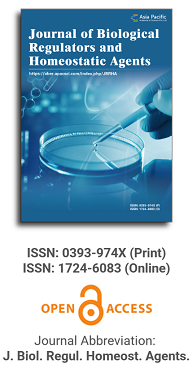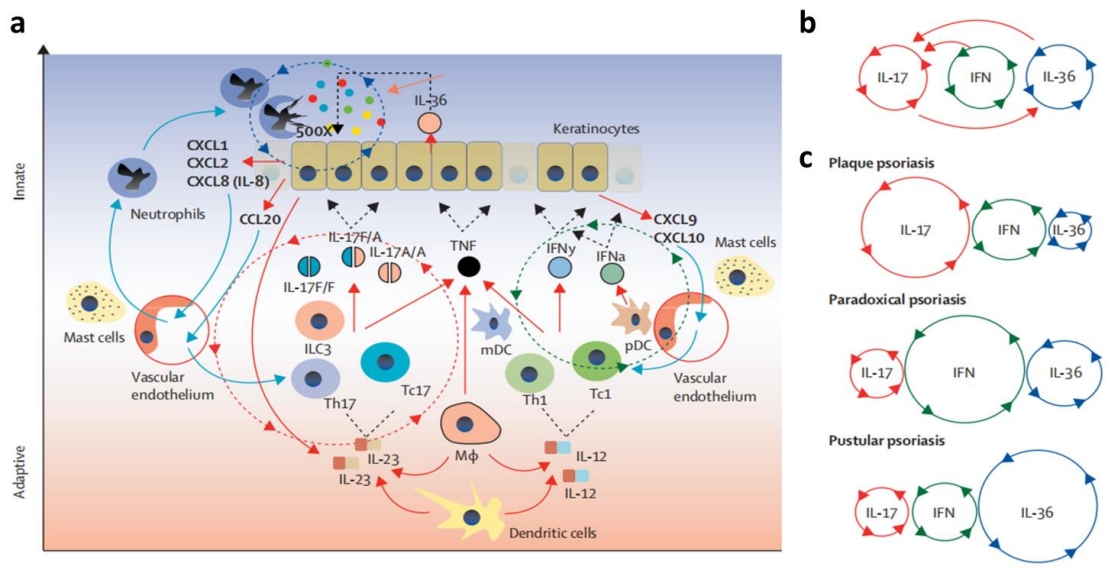
Asia Pacific Academy of Science Pte. Ltd. (APACSCI) specializes in international journal publishing. APACSCI adopts the open access publishing model and provides an important communication bridge for academic groups whose interest fields include engineering, technology, medicine, computer, mathematics, agriculture and forestry, and environment.

Causal relationships between cathepsins and autoimmune diseases: A mendelian randomization study
Vol 39, Issue 2, 2025
Download PDF
Abstract
Background: Epidemiological observational studies investigating the association between cathepsins and autoimmune diseases have shown inconsistent results. Hence, we conducted a Mendelian randomization analysis to assess the potential causal impact of cathepsins on these diseases. Methods: Employing a two-sample Mendelian randomization analysis, we used single nucleotide polymorphisms as instrumental variables to examine the impact of cathepsins on autoimmune diseases. The research comprised univariable and multivariable Mendelian randomization analyses, focusing on individual and combined effects of cathepsins. Statistical techniques included inverse variance weighted method and supplementary methods like MR-Egger for comprehensive assessment. Results: In our Mendelian randomization study, we identified diverse associations between cathepsins and autoimmune diseases. Specifically, cathepsin G was found to significantly increase the risk of myasthenia gravis, while the effects of cathepsin B on rheumatoid arthritis and systemic lupus erythematosus varied. Furthermore, multivariable analysis revealed significant correlations between cathepsins F, G and Z with myasthenia gravis. Importantly, no evidence of reverse causation or horizontal pleiotropy was observed. Conclusion: The study establishes a significant causal relationship between cathepsin G and myasthenia gravis risk.
Keywords
References
- Cao F, Liu YC, Ni QY, et al. Temporal trends in the prevalence of autoimmune diseases from 1990 to 2019. Autoimmunity Reviews. 2023; 22(8): 103359. doi: 10.1016/j.autrev.2023.103359
- Okada Y, Yamamoto K. Genetics and functional genetics of autoimmune diseases. Seminars in Immunopathology. 2022; 44(1): 1-2. doi: 10.1007/s00281-022-00915-x
- Olek MJ. Multiple Sclerosis. Annals of Internal Medicine. 2021; 174(6): ITC81-ITC96. doi: 10.7326/aitc202106150
- Finckh A, Gilbert B, Hodkinson B, et al. Global epidemiology of rheumatoid arthritis. Nature Reviews Rheumatology; 2022.
- Barber MRW, Drenkard C, Falasinnu T, et al. Global epidemiology of systemic lupus erythematosus. Nature Reviews Rheumatology. 2021; 17(9): 515-532. doi: 10.1038/s41584-021-00668-1
- Li DP, Han YX, He YS, et al. A global assessment of incidence trends of autoimmune diseases from 1990 to 2019 and predicted changes to 2040. Autoimmunity Reviews. 2023; 22(10): 103407. doi: 10.1016/j.autrev.2023.103407
- Lenti MV, Rossi CM, Melazzini F, et al. Seronegative autoimmune diseases: A challenging diagnosis. Autoimmunity Reviews. 2022; 21(9): 103143. doi: 10.1016/j.autrev.2022.103143
- Sechi E, Flanagan EP. Antibody-Mediated Autoimmune Diseases of the CNS: Challenges and Approaches to Diagnosis and Management. Frontiers in Neurology. 2021; 12. doi: 10.3389/fneur.2021.673339
- Xu F, Fei Z, Dai H, et al. Mesenchymal Stem Cell‐Derived Extracellular Vesicles with High PD‐L1 Expression for Autoimmune Diseases Treatment. Advanced Materials. 2021; 34(1). doi: 10.1002/adma.202106265
- Cao F, He YS, Wang Y, et al. Global burden and cross-country inequalities in autoimmune diseases from 1990 to 2019. Autoimmunity Reviews. 2023; 22(6): 103326. doi: 10.1016/j.autrev.2023.103326
- Jiang H, Dong Z, Xia X, et al. Cathepsins in oral diseases: mechanisms and therapeutic implications. Frontiers in Immunology. 2023; 14. doi: 10.3389/fimmu.2023.1203071
- Pišlar A, Bolčina L, Kos J. New Insights into the Role of Cysteine Cathepsins in Neuroinflammation. Biomolecules. 2021; 11(12): 1796. doi: 10.3390/biom11121796
- Smyth P, Sasiwachirangkul J, Williams R, et al. Cathepsin S (CTSS) activity in health and disease - A treasure trove of untapped clinical potential. Molecular Aspects of Medicine. 2022; 88: 101106. doi: 10.1016/j.mam.2022.101106
- Wang Y, Zhao J, Gu Y, et al. Cathepsin H: Molecular characteristics and clues to function and mechanism. Biochemical Pharmacology. 2023; 212: 115585. doi: 10.1016/j.bcp.2023.115585
- Hook G, Reinheckel T, Ni J, et al. Cathepsin B Gene Knockout Improves Behavioral Deficits and Reduces Pathology in Models of Neurologic Disorders. Pharmacological Reviews. 2022; 74(3): 600-629. doi: 10.1124/pharmrev.121.000527
- Mustafa A, Elkhamisy F, Arghiani N, et al. Potential crosstalk between pericytes and cathepsins in the tumour microenvironment. Biomedicine & Pharmacotherapy. 2023; 164: 114932. doi: 10.1016/j.biopha.2023.114932
- Ruiz-Blázquez P, Pistorio V, Fernández-Fernández M, et al. The multifaceted role of cathepsins in liver disease. Journal of Hepatology. 2021; 75(5): 1192-1202. doi: 10.1016/j.jhep.2021.06.031
- Stoka V, Vasiljeva O, Nakanishi H, et al. The Role of Cysteine Protease Cathepsins B, H, C, and X/Z in Neurodegenerative Diseases and Cancer. International Journal of Molecular Sciences. 2023; 24(21): 15613. doi: 10.3390/ijms242115613
- Behl T, Chadha S, Sehgal A, et al. Exploring the role of cathepsin in rheumatoid arthritis. Saudi Journal of Biological Sciences. 2022; 29(1): 402-410. doi: 10.1016/j.sjbs.2021.09.014
- Shibamura-Fujiogi M, Yuki K, Hou L. Cathepsin L regulates pathogenic CD4 T cells in experimental autoimmune encephalomyelitis. International Immunopharmacology. 2021; 93: 107425. doi: 10.1016/j.intimp.2021.107425
- Tato M, Kumar SV, Liu Y, et al. Cathepsin S inhibition combines control of systemic and peripheral pathomechanisms of autoimmune tissue injury. Scientific Reports. 2017; 7(1). doi: 10.1038/s41598-017-01894-y
- Li J, Chen Z, Kim G, et al. Cathepsin W restrains peripheral regulatory T cells for mucosal immune quiescence. Science Advances. 2023; 9(28). doi: 10.1126/sciadv.adf3924
- Toomey CB, Cauvi DM, Hamel JC, et al. Cathepsin B Regulates the Appearance and Severity of Mercury-Induced Inflammation and Autoimmunity. Toxicological Sciences. 2014; 142(2): 339-349. doi: 10.1093/toxsci/kfu189
- Dheilly E, Battistello E, Katanayeva N, et al. Cathepsin S Regulates Antigen Processing and T Cell Activity in Non-Hodgkin Lymphoma. Cancer Cell. 2020; 37(5): 674-689.e12. doi: 10.1016/j.ccell.2020.03.016
- Schwenck J, Maurer A, Fehrenbacher B, et al. Cysteine-type cathepsins promote the effector phase of acute cutaneous delayed-type hypersensitivity reactions. Theranostics. 2019; 9(13): 3903-3917. doi: 10.7150/thno.31037
- Galibert M, Wartenberg M, Lecaille F, et al. Substrate-derived triazolo- and azapeptides as inhibitors of cathepsins K and S. European Journal of Medicinal Chemistry. 2018; 144: 201-210. doi: 10.1016/j.ejmech.2017.12.012
- Vidak E, Javoršek U, Vizovišek M, et al. Cysteine Cathepsins and Their Extracellular Roles: Shaping the Microenvironment. Cells. 2019; 8(3): 264. doi: 10.3390/cells8030264
- Zhang TP, Li HM, Leng RX, et al. Plasma levels of adipokines in systemic lupus erythematosus patients. Cytokine. 2016; 86: 15-20. doi: 10.1016/j.cyto.2016.07.008
- Kim J, Ahn M, Choi Y, et al. Upregulation of Cathepsins in Olfactory Bulbs Is Associated with Transient Olfactory Dysfunction in Mice with Experimental Autoimmune Encephalomyelitis. Molecular Neurobiology. 2020; 57(8): 3412-3423. doi: 10.1007/s12035-020-01952-z
- Sasawatari S, Okamura T, Kasumi E, et al. The Solute Carrier Family 15A4 Regulates TLR9 and NOD1 Functions in the Innate Immune System and Promotes Colitis in Mice. Gastroenterology. 2011; 140(5): 1513-1525. doi: 10.1053/j.gastro.2011.01.041
- Suyama M, Koike M, Asaoka D, et al. Increased Immunoreactivity of Cathepsins in the Rat Esophagus under Chronic Acid Reflux Esophagitis. Journal of Histochemistry & Cytochemistry. 2014; 62(9): 645-660. doi: 10.1369/0022155414542300
- Emdin CA, Khera AV, Kathiresan S. Mendelian Randomization. JAMA. 2017; 318(19): 1925. doi: 10.1001/jama.2017.17219
- Lawlor DA, Harbord RM, Sterne JAC, et al. Mendelian randomization: Using genes as instruments for making causal inferences in epidemiology. Statistics in Medicine. 2008; 27(8): 1133-1163. doi: 10.1002/sim.3034
- Davies NM, Holmes MV, Davey Smith G. Reading Mendelian randomisation studies: a guide, glossary, and checklist for clinicians. BMJ; 2018.
- Sun BB, Maranville JC, Peters JE, et al. Genomic atlas of the human plasma proteome. Nature. 2018; 558(7708): 73-79. doi: 10.1038/s41586-018-0175-2
- Burgess S, Davey Smith G, Davies NM, et al. Guidelines for performing Mendelian randomization investigations. Wellcome Open Research. 2019; 4: 186. doi: 10.12688/wellcomeopenres.15555.1
- Bowden J, Del Greco M F, Minelli C, et al. Improving the accuracy of two-sample summary-data Mendelian randomization: moving beyond the NOME assumption. International Journal of Epidemiology. 2018; 48(3): 728-742. doi: 10.1093/ije/dyy258
- Bowden J, Davey Smith G, Burgess S. Mendelian randomization with invalid instruments: effect estimation and bias detection through Egger regression. International Journal of Epidemiology. 2015; 44(2): 512-525. doi: 10.1093/ije/dyv080
- Coss SL, Zhou D, Chua GT, et al. The complement system and human autoimmune diseases. Journal of Autoimmunity. 2023; 137: 102979. doi: 10.1016/j.jaut.2022.102979
- Xiao ZX, Miller JS, Zheng SG. An updated advance of autoantibodies in autoimmune diseases. Autoimmunity Reviews. 2021; 20(2): 102743. doi: 10.1016/j.autrev.2020.102743
- Eggenhuizen PJ, Ng BH, Ooi JD. Treg Enhancing Therapies to Treat Autoimmune Diseases. International Journal of Molecular Sciences. 2020; 21(19): 7015. doi: 10.3390/ijms21197015
- Schett G, Mackensen A, Mougiakakos D. CAR T-cell therapy in autoimmune diseases. Lancet. 2023; 402(10416): 2034-2044. doi: 10.1016/S0140-6736(23)01126-1
- t Hart BA. A Tolerogenic Role of Cathepsin G in a Primate Model of Multiple Sclerosis: Abrogation by Epstein–Barr Virus Infection. Archivum Immunologiae et Therapiae Experimentalis. 2020; 68(4). doi: 10.1007/s00005-020-00587-1
- Khan M, Carmona S, Sukhumalchandra P, et al. Cathepsin G Is Expressed by Acute Lymphoblastic Leukemia and Is a Potential Immunotherapeutic Target. Frontiers in Immunology. 2018; 8. doi: 10.3389/fimmu.2017.01975
- Luo L, Chen H, Xie K, et al. Cathepsin B serves as a potential prognostic biomarker and correlates with ferroptosis in rheumatoid arthritis. International Immunopharmacology. 2024; 128: 111502. doi: 10.1016/j.intimp.2024.111502
- Panwar P, Andrault PM, Saha D, et al. Immune regulatory and anti‐resorptive activities of tanshinone IIA sulfonate attenuates rheumatoid arthritis in mice. British Journal of Pharmacology. 2024; 181(24): 5009-5027. doi: 10.1111/bph.17312
- Su Y, Han Y, Choi HS, et al. Lipid mediators obtained from docosahexaenoic acid by soybean lipoxygenase attenuate RANKL-induced osteoclast differentiation and rheumatoid arthritis. Biomedicine & Pharmacotherapy. 2024; 171: 116153. doi: 10.1016/j.biopha.2024.116153
- Song T, Yao L, Zhu A, et al. Cathepsin B-Activatable Bioactive Peptide Nanocarrier for High-Efficiency Immunotherapy of Asthma. International Journal of Nanomedicine. 2024; 19: 8059-8070. doi: 10.2147/ijn.s455633
- Chen H, Wan L, Qiu Y, et al. Microplastics exposure induced and exacerbated the development of systemic lupus erythematosus in mice. Science of The Total Environment. 2024; 909: 168586. doi: 10.1016/j.scitotenv.2023.168586
- Kawato Y, Fukahori H, Nakamura K, et al. Development of a novel Poly (I: C)-induced murine model with accelerated lupus nephritis and examination of the therapeutic effects of mycophenolate mofetil and a cathepsin S inhibitor. European Journal of Pharmacology. 2023; 938: 175440. doi: 10.1016/j.ejphar.2022.175440
- Xie Z, Zhao M, Yan C, et al. Cathepsin B in programmed cell death machinery: mechanisms of execution and regulatory pathways. Cell Death & Disease. 2023; 14(4). doi: 10.1038/s41419-023-05786-0
- Ma H, Ou Z lin, Alaeiilkhchi N, et al. MiR-223 enhances lipophagy by suppressing CTSB in microglia following lysolecithin-induced demyelination in mice. Lipids in Health and Disease. 2024; 23(1). doi: 10.1186/s12944-024-02185-y
- Fettucciari K, Marguerie F, Fruganti A, et al. Clostridioides difficile toxin B alone and with pro-inflammatory cytokines induces apoptosis in enteric glial cells by activating three different signalling pathways mediated by caspases, calpains and cathepsin B. Cellular and Molecular Life Sciences. 2022; 79(8). doi: 10.1007/s00018-022-04459-z
- Mishiro T, Nakano S, Takahara S, et al. Relationship between cathepsin B and thrombin in rheumatoid arthritis. The Journal of Rheumatology. 2004; 31(7): 1265-73.
- Tong B, Wan B, Wei Z, et al. Role of cathepsin B in regulating migration and invasion of fibroblast-like synoviocytes into inflamed tissue from patients with rheumatoid arthritis. Clinical and Experimental Immunology. 2014; 177(3): 586-597. doi: 10.1111/cei.12357
- Kala M, Chen C, McLachlan SM, et al. Cathepsin S is not crucial to TSHR processing and presentation in a murine model of Graves’ disease. Immunology. 2005; 116(4): 532-540. doi: 10.1111/j.1365-2567.2005.02255.x
- Wu Y, Li Q, Lou Y, et al. Cysteine cathepsins and autoimmune diseases: A bidirectional Mendelian randomization. Medicine. 2024; 103(43): e40268. doi: 10.1097/md.0000000000040268
- Yang H, Kala M, Scott BG, et al. Cathepsin S Is Required for Murine Autoimmune Myasthenia Gravis Pathogenesis. The Journal of Immunology. 2005; 174(3): 1729-1737. doi: 10.4049/jimmunol.174.3.1729
Supporting Agencies
Copyright (c) 2025 Author(s)
License URL: https://creativecommons.org/licenses/by/4.0/

This site is licensed under a Creative Commons Attribution 4.0 International License (CC BY 4.0).

Medical Genetics, University of Torino Medical School, Italy

Department of Biomedical, Surgical and Dental Sciences, University of Milan, Italy

